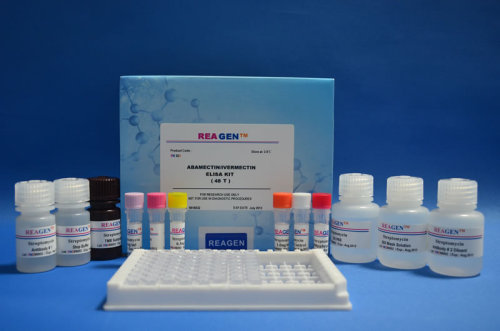1 / 1
Erythromycin ELISA Test Kit
| Model No. : | RND99052 |
|---|---|
| Brand Name : | REAGEN |

Product description
Product Description
REAGEN™Erythromycin ELISA Test Kit is a competitive enzyme immunoassay for the quantitative analysis of Erythromycin in meat(beff,chicken and pork),fish and shrip sampless. The unique features of the kit are:
l High recovery (80-105%),rapid(less than 40 minutes) extraction methods for various samples.
l High sensitivity (0.5ng/g or ppb)and low detection limit (2.5ppb)for fish and shrimp samples.
l High reproducibility..
l A quick ELISA assay(less than 2 hours regardless of number of samples).
Procedure Overview
The method is based on a competitive colorimetric ELISA assay. The drug of interest has been coated in the plate wells. During the analysis, sample is added along with the primary antibody specific for the target drug. If the target is present in the sample, it will compete for the antibody, thereby preventing the antibody from binding to the drug attached to the well. The secondary antibody, tagged with a peroxidase enzyme, targets the primary antibody that is complexed to the drug coated on the plate wells. The resulting color intensity, after addition of substrate, has an inverse relationship with the target concentration in the sample.
Kit Contents, Storage and Shelf Life
REAGEN™Erythromycin ELISA Test Kit has the capacity for 96 determinations or testing of 42 samples in duplicate (assuming 12 wells for standards). Return any unused microwells to the foil bag and reseal them with the desiccant provided in the original package. Store the kit at 2-8°C *. The shelf life is 12 months when the kit is properly stored.
|
Kit Contents |
Amount |
Storage |
|
Erythromycin Coated Plate |
1x 96-well Plate(8wells x12 strips) |
2-8°C |
|
Erythromycin Standards: Negative control (white cap tube) 0.5ng/mL(yellow cap tube) 1.0 ng/mL(orange cap tube) 2.0 ng/mL (pink cap tube) 4.0 ng/mL(purple cap tube) 8.0 ng/mL (blue cap tube) 100 µg/mL (spiking, optional, red cap tube) |
1.0 mL 1.0 mL 1.0 mL 1.0 mL 1.0 mL 1.0 mL
|
2-8°C * |
|
Erythromycin Antibody #1 |
12 mL |
2-8°C |
|
1X HRP Conjugate Antibody #2 |
18 mL |
|
|
20X Wash Solution |
30 mL |
|
|
Stop Buffer |
14 mL |
|
|
TMB Substrate |
10 mL |
|
|
10X PBSr |
25 mL |
* If you are not planning to use the kit for over 1 month, store Erythromycin Standards, Erythromycin Antibody and 1X HRP Conjugate at -20°C or in a freezer.
Sensitivity (Detection Limit)
|
Sample Type |
Detection Limit (ppb) |
|
Meat/Fish/shrip |
2.5 ppb |
Specificity (Cross-Reactivity)
|
Analytes |
Cross-Reactivity (%) |
|
Erythromycin |
100 |
|
Erythromycin Thiocyanate |
110 |
|
Erythromycin Ethylsuccinate |
68 |
|
Kanamycin |
< 0.1 |
|
Tilmicosin |
< 0.1 |
|
Tylosin |
< 0.1 |
Required Materials Not Provided With the Kit
l Microtiter plate reader (450 nm)
l Tissue Mixer (e.g. Omni TissueMaster Homogenizer)
l Vortex mixer (e.g. Genie Vortex mixer from VWR)
l 10, 20, 100 and 1000 µL pipettes
l Multi-channel pipette: 50-300 µL (Optional)
Warnings and Precautions
l The standards contain Erythromycin. Handle with particular care.
l Do not use the kit past the expiration date.
l Do not intermix reagents from different kits or lots except for components with the same part No`s within their expiration dates. ANTIBODIES AND PLATES ARE KIT-AND LOT-SPECIFIC. Make sure that the HRP Conjugate and Diluent are mixed in correct volumes.
l Try to maintain a laboratory temperature of 20°–25°C (68°–77°F). Avoid running assays under or near air vents, as this may cause excessive cooling, heating and/or evaporation. Also, do not run assays in direct sunlight, as this may cause excessive heat and evaporation. Cold bench tops should be avoided by placing several layers of paper towel or some other insulate material under the assay plates during incubation.
l Make sure you are using only distilled or deionized water since water quality is very important.
l When pipetting samples or reagents into an empty microtiter plate, place the pipette tips in the lower corner of the well, making contact with the plastic.
l Incubations of assay plates should be timed as precisely as possible. Be consistent when adding standards to the assay plate. Add your standards first and then your samples.
l Add standards to plate only in the order from low concentration to high concentration, as this will minimize the risk of compromising the standard curve.
Always refrigerate plates in sealed bags with a desiccant to maintain stability. Prevent condensation from forming on plates by allowing them equilibrate to room temperature (20 – 25°C /68 – 77°F) while in the packagingSend your inquiry to this supplier














